Exploring Sharks: Intriguing Facts and Insights


Intro
Sharks have long captured the imagination of countless individuals, from scientists and filmmakers to water sports enthusiasts. As apex predators, they play a crucial role in maintaining the balance of marine ecosystems while showcasing astonishing biological diversity. However, they are also shrouded in myths and misconceptions that often overshadow their importance. Diving into the world of sharks reveals a complex narrative intertwined with conservation challenges and human interaction. This article provides a well-rounded exploration of random shark facts designed to interest both casual readers and marine biologists alike. Our aim is not just to inform, but to cultivate a deeper appreciation for these magnificent creatures.
Techniques and Skills
Understanding sharks requires skill and technique that extend beyond basic knowledge. Whether you are a beginner in the water or an experienced water sports enthusiast, these techniques can enhance your interaction with the marine world.
Essential Techniques for Beginners
For those just starting to explore water activities involving sharks, safety is paramount.
- Observation Skills: Familiarize yourself with shark behavior. Knowing how they move and what signs indicate their presence can enhance your experience.
- Watercraft Handling: If you're kayaking or surfing, mastering basic skills such as balance and maneuverability will keep you safe.
- Respecting the Environment: Maintaining a safe distance from marine life is crucial. Avoid thrashing in the water or creating unnecessary disturbances that could provoke a shark.
Advanced Skills for Experienced Watersport Enthusiasts
Once you’ve got your footing, diving deeper into your skills opens up new opportunities.
- Underwater Navigation: Advanced divers can benefit from knowing how to navigate underwater currents and reading environmental cues.
- Technical Diving: For those who look to engage with sharks up close, advanced certifications can provide valuable skills in handling tricky situations while underwater. Remember though, preparation is key.
- Conservation Engagement: Become more than just an observer; engage with conservation projects that aim to protect sharks and their habitats. Not only does this help the sharks, but it also enriches your experience in the ocean.
Sharks in the Ecosystem
Sharks are often perceived as fierce predators, but their role in the ecosystem goes beyond just hunting. They help regulate fish populations and maintain the health of coral reefs.
Understanding the importance of sharks can foster appreciation and advocacy for their protection. Some key points include:
- Ecosystem Balance: Sharks help keep prey species in check, preventing overpopulation and allowing other marine life to thrive.
- Cultural Symbolism: Across different cultures, sharks are viewed in various lights—from feared predators to revered spirits—highlighting their complexity in human understanding.
- Scientific Advancements: Research on sharks has led to breakthroughs in medicine and technology. Studying their immune systems, for instance, offers insights into disease resistance.
"Sharks ensure the health of the ocean, which in turn supports all marine life, including ourselves."
By understanding sharks better, individuals can help dispel myths and promote marine preservation. Awareness and education are key contributions every water sports enthusiast can make.
Finale
Sharks occupy a significant niche within marine ecosystems, characterized by both beauty and complexity. From technical coastal diving to informative discussions on conservation, the various skills and techniques essential for engaging with sharks open avenues for adventure and awareness. As we explore this captivating world, it becomes our responsibility to cultivate a sense of stewardship for these magnificent creatures. By merging enthusiasm for water sports with a commitment to conservation, each of us plays a part in ensuring a future where sharks can thrive.
Preface to Sharks
Sharks have long captured the imagination of both casual beachgoers and dedicated marine biologists. The importance of understanding sharks extends far beyond their portrayal in films and media. They are often misunderstood creatures whose presence is crucial to marine ecosystems. In this section, we will discuss the essence of sharks, their various kinds, and their role in the delicate balance of oceanic life.
Defining Sharks
Sharks belong to a distinct group of fish known as elasmobranchs, characterized by their cartilaginous skeletons instead of bones. This unique structure allows them to be more agile in their aquatic environment. When seeking to define sharks, it’s essential to recognize their diversity. They vary in size, shape, and color, which fascinates researchers and marine enthusiasts alike. While familiarity with creatures like the Great White or Hammerhead exists, many are unaware of lesser-known species, a point we shall explore further.
Shark Varieties
Sharks are not a one-size-fits-all category; rather, they fall into several families, each with unique traits. This diversity helps underline their importance in the ocean.
Different Families
Looking at the different families of sharks helps one appreciate their adaptation to various habitats. Families like Carcharhinidae, which includes the notorious bull shark, are known for their resilience in environmental changes. These sharks can thrive in both saltwater and freshwater. Understanding these families is beneficial for conservation efforts as it highlights the adaptability of sharks in diverse ecosystems. On the flip side, some families like the Orectolobidae, known for their carpet sharks, have unique features such as the ability to camouflage, which allows them to ambush prey effectively.
Common Species
When speaking of common species, names like the Tiger Shark and the Mako Shark often come to mind. These sharks are crucial not only for ecological balance but also for fisheries. They often serve as indicators of marine health. The unique characteristic of common species is their contribution to the food chain. They help keep the fish populations balanced, which is vital for environmental sustainability. However, their popularity may also lead to overfishing, as they tend to attract both tourism and commercial interests.
Rare Sharks
Rare sharks, such as the Goblin Shark, often invoke awe and intrigue. These species are not just fascinating academically but play essential roles in ecosystem functions too. Their rarity itself can serve as a bellwether for the health of oceanic ecosystems. The particular aspect of rare sharks is that they might possess unique adaptations that reveal much about evolution in marine environments. On the downside, their low population numbers often make them vulnerable to extinction, emphasizing the need for greater awareness in conservation efforts.
Sharks in the Marine Ecosystem
Sharks hold a significant position in marine ecosystems, serving as apex predators. They regulate fish populations, thereby maintaining a balance within the ecosystem. If shark populations decline, the repercussions can ripple through the marine food web. Understanding the integral role they play illustrates the broader impact of conservation efforts aimed at protecting these incredible creatures. By diving deeper into the interactions between sharks and their environments, we can grasp the far-reaching implications of their existence in our oceans.
The Anatomy of Sharks
Understanding the anatomy of sharks is foundational to appreciating their role in marine biology and ecosystems. This section sheds light on the unique physical characteristics that enable sharks to thrive in diverse environments. By gripping the intricacies of their anatomy, we gain insights into their hunting prowess and adaptability.
Unique Physical Features
Cartilaginous Structure
Sharks are primarily composed of cartilage rather than bone, a feature known as their cartilaginous structure. This flexibility offers sharks several advantages. For one, it allows for easier maneuverability in the water, permitting more agile movements when pursuing prey. Additionally, being lighter than bone means sharks can conserve energy while swimming.
Key Characteristic: The remarkable flexibility of cartilage.
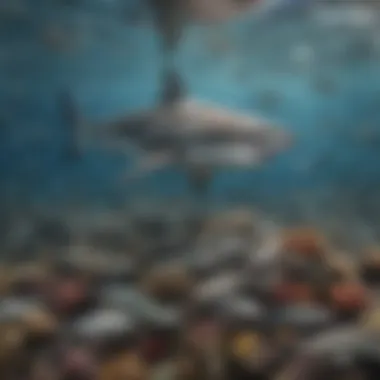
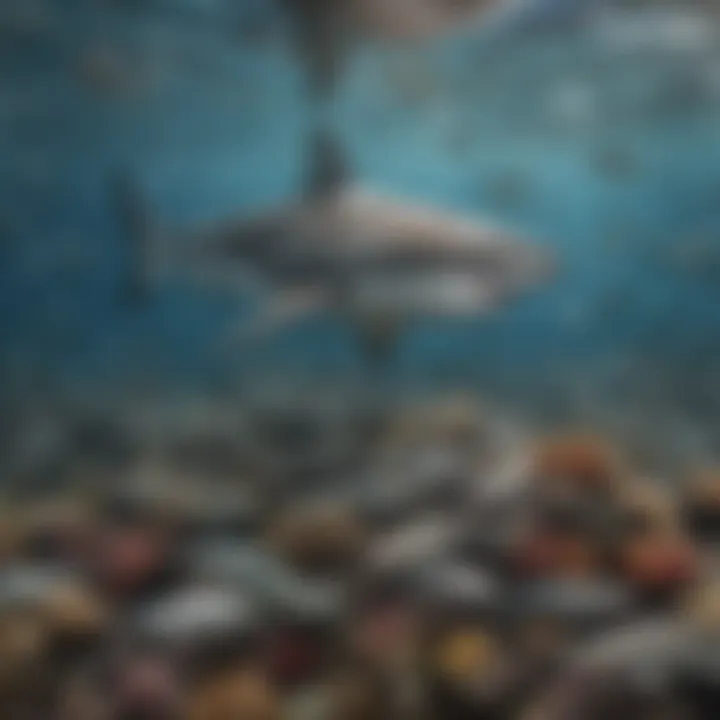
This structural make-up helps sharks reach impressive speeds without expending excessive energy. Their unique skeletons also allow for larger body sizes compared to many bony fish, adding a competitive edge in hunting scenarios. However, this fluid structure also makes them more vulnerable to certain environmental changes, such as declining ocean pH levels due to climate change.
Sensory Organs
Sharks are equipped with sophisticated sensory organs, which play a pivotal role in their predatory lifestyle. Among these, the ampullae of Lorenzini stands out. These tiny, jelly-filled pores help detect electromagnetic fields generated by the movements of potential prey, allowing them to hunt even in murky waters.
Key Characteristic: Advanced electroreception and keen olfactory senses.
The sharks’ sense of smell is astoundingly acute, allowing them to detect blood in the water from miles away. This capability enhances their survival and hunting effectiveness. The downside? The reliance on olfactory cues can render sharks more susceptible to contamination in polluted waters, showcasing the delicate balance of their physiological traits.
Diverse Sizes and Shapes
The astonishing range of sizes and shapes in the shark family is one of its most fascinating aspects. Sharks, ranging from the minuscule Dwarf Lanternshark to the colossal Whale Shark, highlight the adaptability of these species across various marine environments.
From Dwarf Lanternshark to Whale Shark
The Dwarf Lanternshark, measuring scarcely eight inches in length, is not only the smallest shark but also exhibits bioluminescence to evade predators. On the opposite end, the Whale Shark, the largest fish in the ocean, can grow up to 40 feet or more. Its filter-feeding strategy allows it to consume plankton efficiently.
Key Characteristic: The extraordinary size difference and adaptive strategies.
Contrasting shapes and sizes allow sharks to fill specific niches within their environments, showing remarkable diversity. However, larger sharks often face threats from human activities more than their smaller counterparts. Overfishing adversely impacts both populations, underscoring a pressing need for conservation efforts.
"Understanding their anatomy reveals not just how sharks function but also the evolving challenges they face in today's oceans."
With an exploration of unique physical features and size variations, this section underscores the importance of sharks in marine ecosystems while highlighting both their extraordinary adaptations and the threats they now encounter.
Shark Behavior and Intelligence
Shark behavior and intelligence play crucial roles in understanding these complex creatures. Their behaviors not only affect their survival but also have significant impacts on the entire marine ecosystem. Sharks have evolved over millions of years, developing unique hunting strategies, social interactions, and methods of communication. This section delves into these fascinating aspects, will illustrate their adaptive nature, and highlight how they contribute to their ecological niche.
Hunting and Feeding Techniques
Prey Selection
Prey selection is an essential aspect of how sharks hunt, greatly influencing their efficiency and success. Sharks possess a highly developed sense of smell and can detect blood and the slightest chemical changes in the water from miles away. This keen sense allows them to target specific prey, such as seals or smaller fish, that fit their dietary needs, taking into account factors like size and availability.
One unique feature of prey selection is that many sharks, like the great white shark, use a strategy called ambush predation. They often lurk near the surface, camouflaged with the ocean’s lighting, waiting for unsuspecting prey to appear. This method not only conserves energy but increases chances of a successful hunt, making it beneficial for the shark's survival.
However, prey selection also carries its disadvantages; an over-reliance on specific prey types can lead to scarcity when those populations dwindle. Thus, understanding prey selection offers insights not only into shark behavior but also into the health of marine ecosystems as a whole.
Group Hunting
Group hunting behaviors are particularly intriguing when we observe certain shark species, such as the hammerhead and the orca-whale friendly shark, that often hunt collaboratively. This technique enhances their ability to catch larger or more agile prey, like schooling fish. By working together, they can effectively corner their prey, maximizing their chances of a successful catch.
A key advantage of group hunting is that it allows sharks to demonstrate a level of social interaction and intelligence often overlooked. For instance, sharks may herding fish into tighter schools, making them easier to maneuver and capture. However, this technique can backfire; if there’s miscommunication or a lack of coordination among the sharks, it can lead to failure rather than success.
Communication and Social Interaction
Sharks have long been viewed as solitary creatures. However, emerging research indicates that they engage in complex social behaviors. They communicate through body language, electroreception, and even subtle movements within the water. Those signals can indicate aggression or mating readiness, allowing for varied social interactions that are surprisingly sophisticated.
In addition to going after prey in groups, some sharks display social behaviors when swimming together in pods. They utilize these interactions not just for hunting purposes but also during seasonal migrations or in response to environmental factors like water temperatures, proving that their social dynamics are vital for their survival.
"Understanding shark behavior and intelligence helps to illuminate the delicate balance that sustains marine ecosystems."
In summary, recognizing the nuances of shark behavior lays the groundwork for appreciating their role in marine health. By shedding light on their hunting strategies, social interactions, and communication methods, readers can gain a more profound respect for these apex predators and the ecosystems they help to maintain.
Myths and Misconceptions
Understanding the myths and misconceptions surrounding sharks is crucial in dispelling the fears associated with these ocean predators. Society often paints sharks as enemies of humankind, which can skew perceptions and ignore the important role they play in marine ecosystems. By addressing these misconceptions, this article aims to foster a more nuanced understanding of sharks and encourage sustainable practices in ocean exploration and conservation efforts.
Sharks as Human Killers
Statistics on Shark Attacks
The stark reality depicted in statistics on shark attacks often frightens the public into believing that sharks are relentless predators lurking explicitly to attack humans. However, it’s essential to clarify that the odds are heavily tilted in favor of human safety. For example, there are approximately 80 to 100 shark attacks reported worldwide, and fatal encounters are rarer than a winning lottery ticket.
Shark attacks might grab headlines because they evoke strong reactions, but their actual prevalence is minimal. The key characteristic of these statistics is that they highlight over a hundred years worth of data, showing a steady rate of incidents despite a rise in ocean activities like surfing or diving. This article benefits from utilizing these statistics to unveil the stark contrast between public fear and factual reality, ultimately easing apprehension about sharks.
On the downside, relying solely on harsh numbers can sometimes demystify these creatures rather than educate the masses. Engaging narratives about a few incidents do tend to overshadow the importance of context in these statistics.
Understanding Shark Behavior
Understanding shark behavior shifts the focus from the fear of attacks to the fascinating lives of these creatures. It's vital to recognize that sharks don't have a predilection for human flesh; their interest lies predominantly in seals, fish, and other marine life. The key characteristic of this understanding is the emphasis on the natural instincts and feeding patterns of sharks, which often go unacknowledged.
This aspect is beneficial as it provides insights into the cultural narratives surrounding sharks and helps craft a more appreciative image of them. Rather than being brutish, they are complex beings functioning within their ecosystems. However, the challenge lies in simplifying this intricate behavior without losing the essence that sharks are not mindless killers but critical components of marine health.
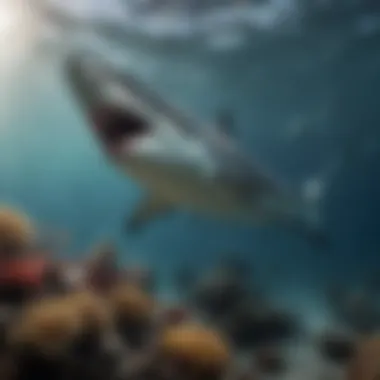
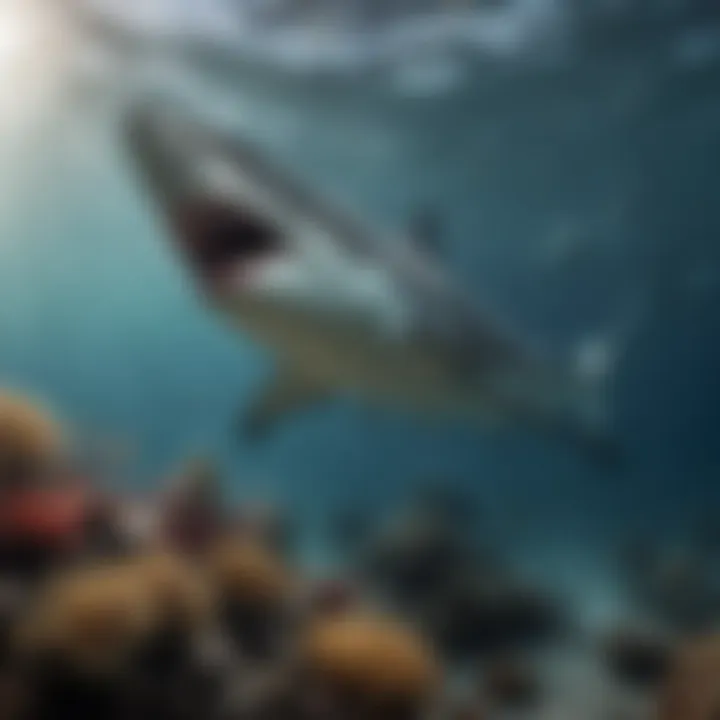
Misinterpretations in Media
The media, in its quest for sensational stories, has often perpetuated myths about sharks. This portrayal skews public perception, linking sharks to fear and horror, as seen in films like "Jaws.”
- The impact of sensationalism: Films and news articles tend to sensationalize shark bites, often leading to the public perception that such events happen frequently. This misinformation leads to increased fear and misunderstanding of sharks.
- Reality check: The truth is, more people die annually from drowning, mosquito bites, and vending machine accidents than from shark attacks.
Cultural Representations of Sharks
The role of sharks in various cultures cannot be overstated, as they have become symbols embodying diverse values and beliefs. From ancient myths to modern cinema, sharks have transcended their natural existence to become icons that evoke fear, admiration, and curiosity. Analyzing these cultural representations helps us understand how sharks are perceived and the impact those perceptions have on their conservation efforts.
Sharks in Mythology
In many cultures, sharks hold a sacred place within myths and folklore. For instance, Hawaiian culture venerates the shark god Kanaloa, linking it to the ocean's mysteries and healing properties. Similarly, several Pacific Islander tribes view sharks as ancestral guardians, often believing that their spirits guide fishermen to abundant waters. These representations are not just fanciful tales; they emphasize respect for the ocean and its creatures, promoting a harmonious relationship with marine ecosystems.
Drawing from mythology helps shore up the narrative that sharks should be seen as protectors of the ocean rather than mere predators. When cultures wrap these apex creatures in stories of respect and reverence, it fosters a more constructive dialogue around their conservation.
Iconic Films and Literature
Film and literature have played a significant role in shaping public perception of sharks over the decades.
Impact on Public Perception
The release of Jaws in 1975 marked a watershed moment in how sharks are viewed. This iconic thriller instilled a deep-rooted fear among beachgoers, persuading them to view sharks as relentless killers. While Jaws is a classic tale, its depiction has had lasting implications.
"Though Jaws was a work of fiction, it sparked a real-life fear that has persisted, affecting both public sentiment and shark conservation."
This film solidified the stereotype of sharks as man-eaters, which simplified the complex reality of shark behavior. This has led to increased shark hunting and a decline in their populations, raising questions about the ethics of such portrayals.
Reflections on Shark Nature
While films like Jaws underscore the idea of sharks as fierce predators, other representations offer a more nuanced view. Documentaries like Sharkwater focus on the environmental roles these creatures play, shedding light on their importance to ocean health. By highlighting their social behaviors and complex hunting patterns, these narratives cultivate a deeper understanding of shark nature.
Understanding how sharks are shaped by cultural narratives is crucial. It reveals an underlying truth about our relationship with these creatures: they are integral to marine ecosystems. Instead of succumbing to fear, engaging with the more holistic aspects of shark behavior can prompt shifts in public perception and conservation priorities.
In sum, the cultural portrayals of sharks in mythology, films, and literature serve as a double-edged sword. They can educate and inspire respect, but can also breed misunderstanding. It is essential to strive for a balance, advocating for a perspective that honors sharks' roles as vital components of marine health, influencing both conservation efforts and human interactions with the ocean.
The Conservation of Sharks
The conservation of sharks is a pressing issue that merits attention, especially as these creatures face multiple threats in today's changing marine environment. Sharks serve vital roles in their ecosystems, acting as apex predators that help maintain the balance of marine life. This section explores the challenges they encounter, along with effective conservation efforts aimed at safeguarding these majestic animals.
Current Threats to Shark Populations
Overfishing
Overfishing is perhaps the most significant threat to shark populations. As demand for shark fins, meat, and other products has surged, commercial fishing practices have drastically reduced their numbers. The key characteristic here is the targeted fishing of species highly valued in markets, like the blue and hammerhead sharks. This practice not only diminishes existing populations but also disrupts the entire marine ecosystem. From a broader perspective, overfishing is a choice that highlights human overexploitation of natural resources, leading to dire consequences for marine biodiversity. The unique feature of this issue lies in its global impact—while local communities may depend on fishing for livelihood, the long-term consequences can mean the loss of an entire species. The disadvantages here are glaring: as sharks decline, the balance of ocean life is altered, paving the way for intermediate species to multiply unchecked, which can cause ecological chaos.
Habitat Loss
Habitat loss due to coastal development, pollution, and climate change directly impacts shark populations. Many species rely on specific environments such as coral reefs and mangroves for breeding and feeding. A notable characteristic of habitat loss is its gradual yet pervasive nature; it may not draw immediate public concern, yet its implications are profound and enduring. This topic is essential as it raises awareness about the underlying causes of habitat degradation, bringing to light the importance of preserving not just sharks, but the ecosystems they inhabit. The unique feature of habitat loss is that it often results from a combination of various human activities—urban expansion, industrial runoff, and tourism can all contribute to diminishing the quality of marine habitats. The advantages of addressing habitat loss include restoring thriving ecosystems that support diverse marine life, not just sharks, thus ensuring a healthier oceanic environment for future generations.
Conservation Efforts
Global Initiatives
Global initiatives play a crucial role in shark conservation. Various organizations, such as Shark Trust and Oceana, are actively working across borders to address the threats sharks face. A key characteristic here is multi-national collaboration, combining efforts from governments, NGOs, and local communities to create protective measures and sustainable fishing practices. These initiatives stand out for their ability to unite various stakeholders, spreading awareness and fostering policies like shark sanctuaries. The unique feature is their broad reach—action taken in one region can positively influence shark populations thousands of miles away. However, global action does face its challenges; varying levels of commitment from countries can impede progress. Nevertheless, these initiatives can spark significant change when they concentrate on education and management.
Local Actions
Local actions represent the grassroots efforts needed to protect shark populations. Community-led projects often focus on sustainable practices tailored to specific geographic areas. A defining aspect of local actions is their adaptability; communities can implement conservation strategies that resonate with local culture while addressing the unique challenges they face. Such actions promote stewardship among residents, ensuring that conservation becomes a part of daily life. A unique feature of local actions is the empowerment of individuals and organizations at the community level; this includes setting up marine protected areas and engaging in local education initiatives. While local actions are often slower to gain traction compared to global initiatives, their deep-rooted connections to local ecosystems can yield meaningful results when sustained over time.
"Conserving sharks goes beyond protecting a single species; it involves a commitment to safeguarding the intricate web of life in our oceans."
Through addressing both the threats and conservation efforts, we can foster a clearer understanding of the importance of sharks in the marine ecosystem while supporting initiatives aimed at their preservation.
Sharks and Human Interaction
Understanding the relationship between sharks and humans is crucial, not just for the sake of safety but also for advancing the conservation of these essential marine creatures. We tend to view sharks through a lens clouded by fear and misconception, often forgetting the role they play in our oceans' ecosystems. This section delves into how humans interact with sharks, emphasizing the need for protective measures as well as the burgeoning trend of shark tourism, which has both upsides and downsides.
Protective Measures for Swimmers
When venturing into waters inhabited by sharks, it is vital to adopt a few protective measures. Swimmers can significantly reduce the risks of unwanted encounters with sharks by keeping the following tips in mind:
- Avoid Swimming Alone: Sharks are more likely to approach a solitary swimmer than a group. Staying with others can deter sharks that are curious.
- Wear Bright or Dark Colors: Distinctive colors make it easier for divers to be seen by boaters, thus reducing the chances of accidents while in shark-prone areas.
- Stay Calm and Avoid Splashing: Rapid movements can mimic the behavior of struggling prey, which may attract sharks to investigate. Remaining calm can help alleviate curiosity.
- Know the Environment: Research the area before swimming. Being aware of any sharks that frequent the vicinity can inform better choices.
- Avoid Early Morning and Dusk Swims: Sharks tend to be more active during these times, making it wise to steer clear.
Implementing these strategies creates a safer experience not only for ourselves but also may contribute to reducing shark anxiety in the ecosystem.

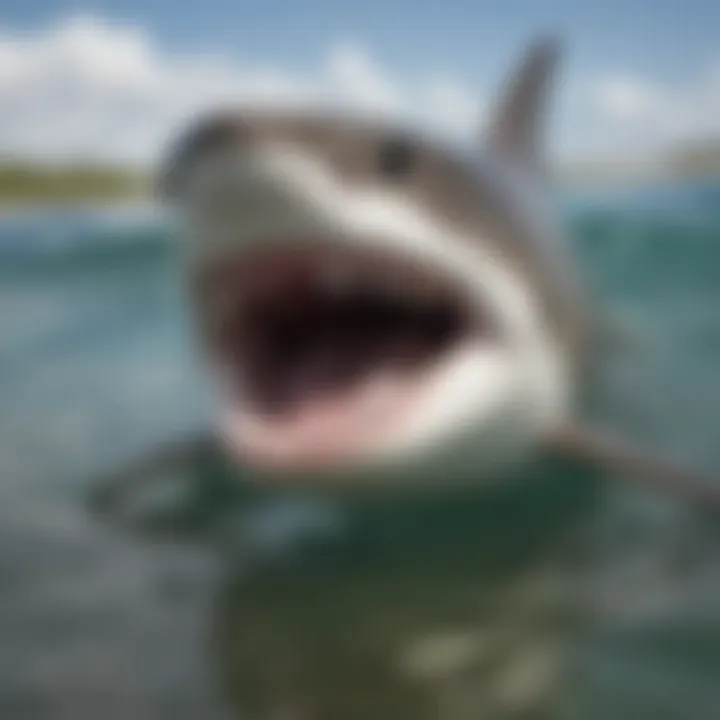
Shark Tourism and its Effects
Shark tourism is a fascinating endeavor that brings people close to these magnificent creatures. As more enthusiasts pursue interactions with sharks through diving trips or cage experiences, it is essential to understand its impact on marine life and local economies.
Benefits
The benefits of shark tourism are notable. First and foremost, it raises awareness about shark conservation. When individuals witness sharks up close, their perception often shifts from fear to fascination. This experiential understanding can foster advocacy for preservation efforts. The economic implications are equally significant, as shark-related tourism can contribute substantially to local economies through diving operations, guided tours, and eco-friendly activities. This financial incentive motivates communities to protect sharks, rather than see them as threats. Overall, the uniqueness of engaging directly with sharks offers both an educational and economic lifeline to undervalued coastal habitats.
Risks
However, it’s not all sunshine and rainbows. There are also risks linked to shark tourism that cannot be overlooked. One major concern is the potential for negative behavioral changes in sharks themselves. Regular encounters with humans can alter their natural instincts, sometimes leading to increased risk. Furthermore, poorly managed tourism can result in environmental degradation if operators do not follow environmentally friendly practices. This could disrupt delicate ecosystems and harm shark populations.
Therefore, a delicate balance is necessary. While shark tourism can generate significant positives, it must be conducted in a responsible manner. Ensuring that tour operators are held to standards of ethical treatment provides benefits that can last for generations.
"Education and awareness can turn fearful attitudes into admiration for sharks, shifting the narrative from predators to protectors of the ocean."
In summary, the interplay between sharks and humans is complex, filled with opportunities and pitfalls alike. By implementing protective measures while understanding the implications of shark tourism, we can continue exploring these fascinating marine animals without jeopardizing their existence.
Innovations in Shark Research
Research on sharks is crucial not only for understanding these magnificent creatures themselves but also for grasping their role in the marine ecosystem. Innovations in shark research have become focal points for scientists and conservationists alike, owing to the pressing need for data that can aid in the preservation of shark populations. These advancements provide the tools necessary to track sharks in real-time and analyze genetic data, promoting informed conservation strategies.
Tagging and Tracking
Tagging and tracking sharks has revolutionized the way scientists study their behavior and migration patterns. Traditionally, observing these creatures in their natural habitat was akin to looking for a needle in a haystack. Now, with the aid of various tagging techniques, researchers can gather invaluable data on sharks' movements, habitat choices, and feeding behaviors.
Tags like pop-up satellite tags and acoustic tags allow scientists to gather information over long periods, providing a clearer picture of shark dynamics. The insights gained from these devices enlighten our understanding of how these predators interact with their environments, as well as contributing to ongoing discussions about fisheries and conservation management.
Technological Advancements
Drones and Submersibles
The use of drones and submersibles in shark research is becoming increasingly important, and for good reason. Drones offer a bird’s-eye view of marine environments without the interference that boats often cause. They can cover vast areas in a fraction of the time it would take to do so by traditional means. This is especially helpful for monitoring shark populations, as researchers can observe behaviors or patterns without disturbing the animal's natural activities.
Specifically, the aerial perspective provided by drones assists in tracking schooling behaviors and monitoring breeding grounds. Moreover, submersibles allow researchers to dive deeper than standard scuba and interact with sharks in a minimally invasive manner. The unique feature of these vessels is their ability to navigate depths that traditional equipment cannot reach, providing a clearer lens into the lives of elusive species.
However, while drones offer a wealth of visual information, they can be limited by weather conditions, and submersibles, while equipped with advanced tech, can be costly to operate.
Genetic Studies
Another promising avenue in shark research is genetic studies, which are pivotal for understanding population structures and genetic diversity within various species. This aspect of research is key in determining how isolated populations are, which has implications for their vulnerability to environmental changes and human activities.
Genetic analysis helps scientists identify distinct populations that may require separate management strategies. By understanding genetic differentiation, conservationists can tailor their efforts more effectively to ensure the survival of different species.
The unique characteristic of genetic studies is that they can reveal information that is not visible through behavioral observation alone. However, conducting extensive genetic studies can be labor-intensive and requires significant funding and resources, which can limit widespread implementation.
In summary, innovations in tagging, tracking, and genetic studies provide essential insights into shark behavior and help shape effective conservation strategies, ensuring these incredible creatures continue to thrive in our oceans.
In closing, the topic of understanding sharks is crucial for both enthusiasts and casual observers alike. Sharks, often misjudged as relentless predators, play a fundamental role in the health of our oceans. By unraveling the various dimensions surrounding these creatures—from their biology to their conservation needs—we create a more informed public. This article instills a sense of obligation towards these apex predators while fostering appreciation among water sports enthusiasts and those curious about marine life.
The Importance of Education
Dispelling Myths
Education about sharks goes hand in hand with dispelling myths. For too long, the narrative painted them as mindless killers lurking beneath the waves. This idea hooks popular culture, often exaggerating the danger they pose to humans. The fact is, shark attacks are exceedingly rare. By showcasing statistics and scientifically-backed behavior analysis, we can carve away that fear. A key attribute of dispelling myths is how it transforms perception, shifting the public view from skepticism to understanding. This is beneficial because it opens avenues for discussion instead of fear.
The unique feature here is the ability to use education as a tool for change. Knowledge, when disseminated effectively, empowers individuals. A significant advantage in this context is that the process can spur interest in conservation efforts, encouraging people to engage more deeply with issues affecting marine life.
Spreading Awareness
Alongside education, spreading awareness is of utmost importance. It not only informs but also engages the community in active discussions about shark conservation. Through social media campaigns, outreach programs, and public lectures, we can paint a more accurate picture of shark behaviors and their ecological significance. The engagement in these activities serves as a powerful motivator for collective action.
The hallmark of spreading awareness is its ability to reach diverse audiences. This versatility is beneficial because it means anyone—from school kids to seasoned divers—can participate. However, while spreading awareness can yield positive outcomes, challenges may arise with misinformation circulating alongside. Thus, credibility becomes essential in crafting these messages, ensuring the audience receives factual content.
Call to Action
Supporting Conservation Initiatives
One of the most impactful ways individuals can contribute to the preservation of sharks is by supporting conservation initiatives. Organizations dedicated to this cause implement critical measures—whether it be protecting local habitats or lobbying against harmful fishing practices. When someone chooses to support these initiatives, they are helping create a safer future for sharks. This commitment fosters a supportive network where common goals can be shared and advanced.
A standout characteristic of supporting conservation initiatives is that it offers laypeople tangible avenues to enact change. This is beneficial as it bridges the gap between knowledge and action. However, it's important to note that not all initiatives function equally. Transparency and effectiveness should be key considerations as individuals select which organizations to back.
Engaging with Research
Finally, engaging with research serves as a robust avenue to further illuminate the mysteries surrounding sharks. Ongoing studies yield invaluable insights, shedding light on shark behaviors, migratory patterns, and overall health metrics. This constant influx of information keeps the public—especially the enthusiasts—updated on developments while inspiring further inquiries about marine biology.
What sets engaging with research apart is the dynamic exchange between scientists and the general public. Public participation in research projects can generate further interest and investment into shark conservation. Yet, while this engagement is overwhelmingly positive, individuals should be aware of the varying quality of research sources, emphasizing the need for credible information.
In essence, understanding sharks is more than just an academic exercise; it is a communal responsibility to ensure a thriving ocean ecosystem for generations to come.
By grasping these important aspects, not only does one become an advocate for the sharks, but also a steward for the wider marine environment. Wherever one ventures into the ocean, this understanding can lead to more thoughtful interactions with the sea’s many inhabitants.







